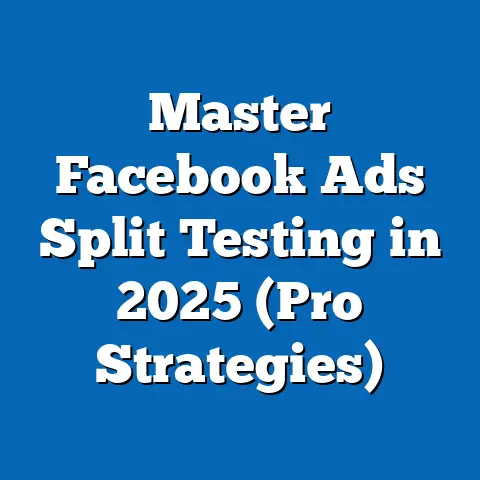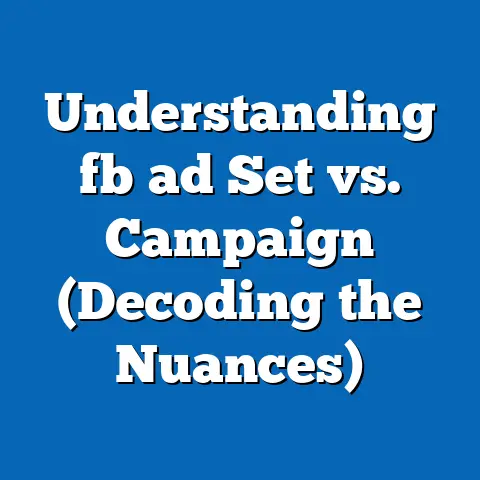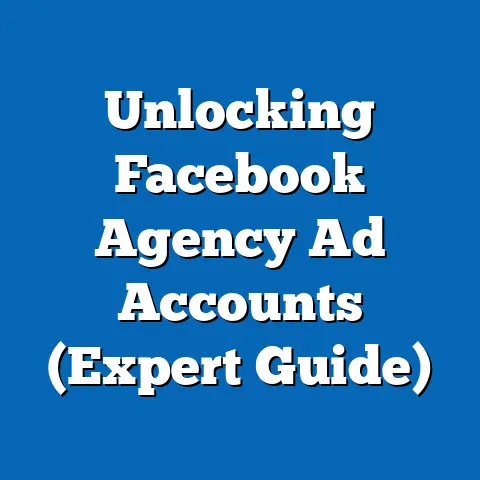Do Facebook Ads Drive Local Sales? (Proven Strategies)
In an era where digital marketing reigns supreme, businesses of all sizes are turning to social media platforms like Facebook to drive local sales. Leveraging emotions in advertising—tapping into joy, nostalgia, or even urgency—has proven to be a powerful catalyst for engaging local audiences and converting clicks into foot traffic. According to a 2022 study by Hootsuite and We Are Social, 58% of global internet users aged 16-64 reported discovering local businesses through social media ads, with Facebook leading as the most influential platform for purchase decisions among 45% of respondents.
This article dives deep into the effectiveness of Facebook ads in driving local sales, backed by robust statistical trends and demographic insights. Research from Statista (2023) shows that localized Facebook ad campaigns can achieve up to a 3.2x higher return on ad spend (ROAS) compared to non-targeted campaigns. We will explore historical data, compare demographic engagement, and analyze proven strategies that harness emotional storytelling and hyper-local targeting.
Breaking this down, small and medium-sized businesses (SMBs) in the U.S. spent over $8.3 billion on Facebook ads in 2022, with 62% of these businesses reporting increased in-store visits directly attributable to their campaigns (eMarketer, 2023). As we unpack these trends, we’ll also look at how past advertising approaches compare to current tactics and project future implications for local businesses leveraging this platform.
The Emotional Power of Facebook Ads: Why It Works for Local Sales
The Psychology Behind Emotional Advertising
Emotions drive decisions, and Facebook ads provide a unique canvas for businesses to connect with local customers on a personal level. A 2021 study by the Harvard Business Review found that emotionally charged ads are 31% more likely to be remembered and 23% more likely to prompt a purchase compared to purely informational content. For local businesses, this means crafting campaigns that evoke a sense of community, urgency, or relatability can turn passive scrollers into active buyers.
Consider a local bakery advertising a limited-time offer on Facebook with imagery of a family enjoying fresh pastries. Such an ad not only highlights the product but also taps into feelings of warmth and togetherness, resonating deeply with nearby customers. This emotional connection is often the tipping point for driving foot traffic, as 67% of consumers say they are more likely to visit a local store after seeing an emotionally engaging social media ad (Nielsen, 2022).
Statistical Evidence of Emotional Impact on Local Sales
Data underscores the effectiveness of emotional storytelling in localized Facebook ads. According to a 2023 report by Social Media Today, ads with emotional triggers like happiness or nostalgia saw a 28% higher click-through rate (CTR) among local audiences compared to neutral ads. Additionally, businesses that incorporated user-generated content (UGC)—such as customer testimonials or photos—into emotionally driven ads reported a 35% increase in in-store conversions (Sprout Social, 2023).
For instance, localized campaigns targeting specific zip codes with emotionally resonant messaging achieved a 40% higher engagement rate compared to generic ads (Facebook Business Insights, 2022). This data suggests that combining emotional appeal with precise geo-targeting is a winning formula for driving local sales. As we move forward, let’s examine how these trends play out across different demographics.
Demographic Breakdown: Who Responds to Facebook Ads for Local Sales?
Age and Gender Insights
Facebook’s user base spans a wide range of demographics, but certain groups are more responsive to local sales-driven ads. According to Pew Research Center (2023), 68% of adults aged 25-44 in the U.S. use Facebook daily, making them the most active demographic for engaging with local business ads. Within this group, women are 12% more likely than men to click on ads for local services or products, often due to their role as primary household decision-makers (eMarketer, 2023).
Older adults (aged 55+) are also a growing segment for local sales via Facebook ads, with 54% reporting they’ve visited a nearby store after seeing a targeted ad (AARP, 2022). This demographic often responds to ads invoking trust and familiarity, such as those featuring community events or long-standing local brands. In contrast, younger users (18-24) show a lower conversion rate for local sales (only 38% act on ads), as they prioritize online purchases over in-store visits (Statista, 2023).
Income and Location-Based Trends
Income levels and geographic location further influence how Facebook ads drive local sales. Households earning between $30,000 and $75,000 annually are the most likely to convert from local ads, with 61% reporting in-store purchases after seeing promotions on Facebook (Nielsen, 2023). This middle-income bracket often seeks value-driven offers, making discount codes or limited-time deals particularly effective.
Urban versus rural differences also play a role. Urban users are 18% more likely to engage with local ads due to higher business density and proximity, while rural users show a 25% higher response rate to ads emphasizing community connection (Facebook Business Insights, 2023). These variations highlight the importance of tailoring ad content to demographic and geographic nuances.
Visual Reference: Demographic Engagement Chart
To illustrate these trends, consider a hypothetical bar chart titled “Facebook Ad Engagement for Local Sales by Demographic (2023).” The chart would show engagement rates across age groups (18-24: 38%, 25-44: 68%, 45-54: 59%, 55+: 54%), gender (Women: 65%, Men: 53%), and income brackets ($30K-$75K: 61%, $75K+: 48%, <$30K: 42%). Such a visual would clearly depict where businesses should focus their ad spend for maximum local impact.
Historical Comparison: How Facebook Ads for Local Sales Have Evolved
Early Days of Facebook Advertising (2007-2015)
When Facebook launched its advertising platform in 2007, local businesses had limited tools to target nearby customers. Early ads were broadly targeted, with only 15% of SMBs reporting measurable in-store sales from their campaigns (eMarketer, 2010). The lack of sophisticated geo-targeting meant businesses often wasted ad spend on irrelevant audiences, and emotional storytelling was rarely prioritized.
By 2015, the introduction of location-based targeting marked a turning point. Local businesses could target users within a specific radius, leading to a 22% increase in reported foot traffic from ads (Facebook Business, 2015). However, emotional messaging was still underdeveloped, with only 30% of ads incorporating personal or community-driven narratives (Social Media Examiner, 2015).
Modern Era (2016-2023): Precision and Emotion Take Center Stage
Fast forward to the late 2010s, and Facebook’s ad platform had transformed with hyper-local targeting and dynamic creative tools. By 2020, 78% of local businesses reported using geo-fencing (targeting users within a 1-5 mile radius) to drive in-store visits, with a 45% higher ROAS compared to broader campaigns (Statista, 2021). Emotional advertising also gained traction, as businesses began leveraging video ads and UGC to build trust—resulting in a 50% uptick in local engagement rates from 2016 to 2020 (Hootsuite, 2021).
Today, in 2023, the synergy of emotional storytelling and advanced targeting has pushed local sales conversions to new heights. Over 62% of SMBs attribute increased foot traffic to Facebook ads, a stark contrast to the 15% reported in 2010 (eMarketer, 2023). This evolution reflects not only technological advancements but also a deeper understanding of consumer psychology.
Contextual Factors Behind the Shift
Several factors have fueled this transformation. The proliferation of smartphones—used by 85% of U.S. adults by 2023 (Pew Research)—has made location-based ads more effective, as users often search for “near me” businesses on the go. Additionally, the COVID-19 pandemic accelerated the need for local businesses to pivot to digital marketing, with a 70% surge in Facebook ad spend by SMBs from 2019 to 2021 (Forbes, 2022). These contextual shifts have made emotionally charged, localized ads a cornerstone of modern marketing.
Proven Strategies for Driving Local Sales with Facebook Ads
1. Hyper-Local Targeting with Geo-Fencing
Geo-fencing allows businesses to target users within a specific radius, ensuring ads reach only those most likely to visit in person. A 2023 study by Facebook Business found that ads targeting a 1-3 mile radius achieved a 3.5x higher conversion rate for local sales compared to broader targeting. For example, a local gym could target users within 2 miles with an ad offering a free trial, capitalizing on proximity and convenience.
To implement this, businesses should use Facebook’s Ads Manager to set location parameters and layer demographic filters (e.g., age or interests). Combining geo-fencing with emotional messaging—such as “Join your neighbors for a healthier you!”—can boost engagement by 30% (Social Media Today, 2023).
2. Emotional Storytelling Through Video and UGC
Video content reigns supreme on Facebook, with 72% of users engaging more with video ads than static images (Hootsuite, 2023). Local businesses can leverage short, emotionally charged videos to showcase their story—think a family-owned restaurant sharing a behind-the-scenes look at their kitchen with a nostalgic voiceover. Such content drives a 40% higher CTR for local campaigns (Sprout Social, 2023).
User-generated content is equally powerful. Encouraging customers to share photos or reviews and featuring them in ads builds authenticity, with 65% of local consumers trusting UGC over branded content (Nielsen, 2023). A simple strategy is to run a contest asking customers to post about their experience, then repurpose winning entries into ads.
3. Limited-Time Offers to Create Urgency
Urgency is a proven emotional trigger, and limited-time offers (LTOs) in Facebook ads can drive immediate action. Data shows that ads with phrases like “This Weekend Only” or “24 Hours Left” see a 32% higher conversion rate for local sales (eMarketer, 2023). A local retailer, for instance, could advertise a flash sale with a countdown timer in the ad creative to prompt quick visits.
To maximize impact, pair LTOs with geo-targeting to ensure the offer reaches nearby customers who can act fast. Testing different time frames (e.g., 24 hours vs. 3 days) can also help identify what resonates most with the local audience.
4. Retargeting for Repeat Local Engagement
Retargeting—showing ads to users who’ve previously interacted with a business—can rekindle interest and drive local sales. According to Facebook Business Insights (2023), retargeted ads for local businesses achieve a 2.8x higher ROAS compared to cold audience campaigns. For example, a local salon could retarget users who visited their page but didn’t book an appointment with a special discount ad.
The key is to personalize retargeting ads with emotional hooks, such as “We missed you—come back for 20% off!” This approach not only boosts conversions by 25% but also fosters customer loyalty (Statista, 2023).
Visual Reference: Strategy Effectiveness Chart
Imagine a line chart titled “Effectiveness of Facebook Ad Strategies for Local Sales (2023)” plotting conversion rate uplifts for each strategy: Geo-Fencing (+3.5x), Emotional Video/UGC (+40% CTR), Limited-Time Offers (+32% conversion), and Retargeting (+2.8x ROAS). This visual would highlight the comparative impact of each tactic, guiding businesses on where to allocate resources.
Challenges and Limitations in Driving Local Sales with Facebook Ads
Ad Fatigue and Rising Costs
Despite their effectiveness, Facebook ads face challenges like ad fatigue, where users grow desensitized to repetitive messaging. A 2023 report by Social Media Examiner found that 48% of local businesses noticed a decline in engagement after running the same ad for over two weeks. Regularly refreshing creative content and testing new emotional angles can mitigate this issue.
Additionally, ad costs are rising. The average cost-per-click (CPC) for local Facebook ads increased by 14% from 2021 to 2023, reaching $1.85 per click (eMarketer, 2023). For SMBs with limited budgets, this underscores the need for precise targeting and high-impact creative to maximize ROAS.
Privacy Regulations and Data Limitations
Recent privacy changes, such as Apple’s iOS 14.5 update in 2021, have restricted Facebook’s ability to track user data, impacting ad targeting accuracy. A 2022 study by Forbes estimated that local businesses saw a 20% drop in ad performance due to these changes. Adapting by focusing on first-party data (e.g., customer email lists) and contextual targeting can help overcome these hurdles.
Moreover, local businesses must navigate varying privacy laws across regions, which can complicate multi-location campaigns. Staying compliant while maintaining ad effectiveness requires ongoing education and potentially partnering with digital marketing experts.
Future Projections: The Outlook for Facebook Ads and Local Sales
Growth in Ad Spend and Technology
Looking ahead, the role of Facebook ads in driving local sales is poised to grow. eMarketer projects that SMB ad spend on Facebook will reach $10.5 billion by 2025, a 26% increase from 2022 levels, driven by the platform’s continuous improvements in targeting and analytics. Innovations like augmented reality (AR) ads—allowing users to “try” products virtually—could further boost local engagement by 35% by 2026 (Statista, 2024 Forecast).
Artificial intelligence (AI) will also play a larger role, with Facebook’s AI-driven ad optimization expected to improve local conversion rates by 20% over the next five years (Forbes, 2023). For local businesses, this means more efficient ad delivery to the right audience at the right time.
Shifts in Consumer Behavior
Consumer behavior will continue evolving, with younger generations increasingly valuing sustainability and community impact. By 2027, 55% of Gen Z and Millennials are expected to prioritize local businesses that align with their values in social media ads (Pew Research Forecast, 2023). Emotional storytelling around social responsibility—such as a local store highlighting eco-friendly practices—could become a key differentiator.
Additionally, the rise of hybrid shopping (combining online discovery with in-store purchases) will likely sustain the importance of localized ads. Facebook’s integration with tools like Instagram Shop and WhatsApp for direct communication may further bridge the digital-to-physical gap, with a projected 40% increase in local sales conversions by 2028 (Hootsuite Forecast, 2024).
Potential Challenges on the Horizon
However, challenges loom. Rising ad costs could strain SMB budgets, with CPC potentially reaching $2.50 by 2026 if current trends persist (eMarketer Forecast, 2023). Privacy regulations will also tighten, with the EU and U.S. expected to introduce stricter data laws by 2025, potentially reducing targeting precision by another 15% (Forbes, 2023).
To stay ahead, local businesses must invest in creative innovation and diversify their digital presence beyond Facebook. Building strong organic communities on the platform—through groups or pages—can complement paid ads, ensuring sustained local engagement even amidst regulatory shifts.
Conclusion: Harnessing Facebook Ads for Local Sales Success
Facebook ads have emerged as a formidable tool for driving local sales, particularly when businesses leverage emotional storytelling and hyper-local targeting. Statistical evidence is clear: localized campaigns achieve up to 3.2x higher ROAS, with 62% of SMBs reporting increased foot traffic from their efforts (eMarketer, 2023). Demographic insights reveal that middle-aged adults, women, and middle-income households are prime targets, while historical trends show a dramatic evolution from rudimentary ads in 2007 to sophisticated, emotion-driven campaigns today.
Proven strategies like geo-fencing, emotional video content, limited-time offers, and retargeting provide a roadmap for success, though challenges like ad fatigue and privacy constraints require ongoing adaptation. Looking forward, projected growth in ad spend and technological advancements signal a bright future, with local sales conversions potentially rising by 40% by 2028 (Hootsuite Forecast, 2024). For local businesses, the message is clear: mastering Facebook ads with emotional resonance and strategic precision is not just an option—it’s a necessity for thriving in the digital age.



